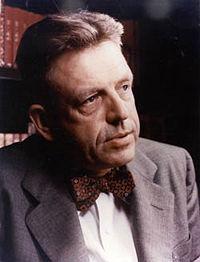The Kinsey Institute
The Kinsey Institute for Research in Sex, Gender, and Reproduction is one of the oldest research institutes in the United States concerned primarily with the exploration of sexual behavior. The brainchild of Alfred Kinsey, the Institute was founded in 1947 and has been attracting attention from sources ever since, ranging from the Catholic Church’s condemnation to Hollywood’s production of a major motion picture.
The History of the Kinsey Institute
Before the Institute
Alfred Kinsey graduated from Bowdoin College with B.S.’s in both biology and psychology. In September of 1919, he received a Sc.D. in biology from Harvard University, and joined Indiana University’s biology department in 1920, as an assistant professor of zoology. Kinsey soon gained popularity among his
students and developed a reputation as “the sex doctor.” The University asked Kinsey to teach a course for married students and students considering marriage, but he found that research on human sexuality was exceedingly rare. To address this lack of data, Kinsey began interviewing students about their sexual habits in the hopes of compiling information on this under-researched topic. Kinsey soon started interviewing a broader number of people across the United States, including new acquaintances. In 1940, his sex research became his primary project, and in 1947, the National Research Council began funding Kinsey’s collection and analysis of sex histories and formed the Indiana University Institute for Sex Research.
Kinsey’s Research
Through funding for the Institute, Kinsey compiled the information needed to write two major books, Sexual Behavior in the Human Male (1947) and Sexual Behavior in the Human Female (1953). Both of these volumes contained detailed descriptions of the sexual behaviors of his interviewees, almost all of which were considered exceptionally taboo. From childhood masturbation to bestiality, Kinsey discussed a number of sexual behaviors he found surprisingly common among the people he interviewed. Kinsey and other researchers were able to interview more than 18,000 people over the span of the information-collection project, which ended in 1963.
Controversy
Kinsey sought to provide accurate information about human sexual behavior despite the conflict it had with society and the consequences that were to follow the production of both his books. a result, the response Kinsey received about his research were both discouraging and encouraging. “Scientists and clergymen here were strongly divided today over the merits of Dr. Alfred Kinsey’s survey of the sexual behavior of women. “Shocking,” “disgusting,” “distorted,” were some of the descriptions by clerics of the 800-page volume. “Necessary,” “enlightening” and “revealing” were others voiced by men in research fields allied to Kinsey’s” (Gilbert 1953). In spite of the controversy that followed Kinsey and his research, he found much help from then-president of Indiana University, Herman B. Wells, in his efforts to keep his research efforts solvent.
Kinsey and Homosexuality
Kinsey became a vital part of the homosexual revolution after revealing to the world how common homosexual behaviors are. Kinsey found that on the whole, homosexual child play in males occurs more frequently and more specifically than pre-adolescent heterosexual play (Kinsey 1948, 168). Similarly, Kinsey reported that homosexual activities are engaged by about 60 per cent of pre-adolescent boys (Kinsey 1948, 610).
Kinsey developed the “Kinsey Scale,” which described homosexuality and heterosexuality as a fluid spectrum. This scale challenged the belief that sexual orientation is black and white—that is, the belief that one can be exclusively homosexual and heterosexual. This has allowed people to realize that though one identifies as heterosexual, homosexual thoughts, feelings, and actions are also normal to experience. Kinsey’s research has revolutionized the world’s view about homosexuality and many other topics related to deviant sexuality. As he persevered through the controversy of his research, Kinsey contributed to the new way people view homosexuality and human sexual behavior as a whole.
Bibliography
Capshaw, James H. “Alma Pater: Herman B Wells and the Rise of Indiana University.” Indiana University. http://www.indiana.edu/~libarch/Wells/wellsbio.html.
“Facts about Kinsey, the film.” The Kinsey Institute for Research in Sex, Gender, and Reproduction, Inc. http://www.kinseyinstitute.org/about/Movie-facts.html
Gilbert, Justin. “Clerics, Educators Comment on Report.” Mirror, (New York, N.Y.) Aug 20, 1953.
Kinsey, Alfred C., Wardell B. Pomeroy, Clyde E. Martin. Sexual Behavior in the Human Male. Bloomington: Indiana University Press, 1948.
Kinsey. DVD. Directed by Bill Condon. 2004. Century City, CA: Fox Searchlight Pictures, 2004.
“Origin of the Institute.” The Kinsey Institute for Research in Sex, Gender, and Reproduction, Inc. http://www.kinseyinstitute.org/about/origins.html.
“Photo History.” The Kinsey Institute for Research in Sex, Gender, and Reproduction, Inc. http://www.kinseyinstitute.org/about/photo-tour.html.
Reisman, Judith. “Kinsey and the Homosexual Revolution.” Leadership U. 13 July 2002. http://www.leaderu.com/jhs/reisman.html.
“Response to Controversy.” The Kinsey Institute for Research in Sex, Gender, and Reproduction, Inc. http://www.kinseyinstitute.org/about/controversy.html.
Schmalz,Valerie. “Alfred Kinsey: Father of Sexual Revolution.” Ignatius Insight. http://www.ignatiusinsight.com/features/vschmalz_kinsey_nov04.asp.
